Welcome to Kusina Secrets! This Adobong Talong recipe brings the humble eggplant to life with tangy vinegar, savory soy sauce, and plenty of garlic. I've been making this dish for years, and it never fails to impress both Filipino food lovers and newcomers alike.
The tender eggplant soaks up all those delicious adobo flavors, creating a mouthwatering side dish that pairs perfectly with steamed rice. The best part? It's ready in just 30 minutes, making it perfect for busy weeknight dinners.
What is Adobong Talong?
Adobong Talong is a Filipino vegetable dish where eggplants ("talong" in Tagalog) are cooked in the classic adobo style - with vinegar, soy sauce, and garlic. This cooking method was originally used for preserving food in the tropical Philippine climate, but has become one of the country's most beloved flavor profiles. The eggplants are first pan-fried and then simmered in the adobo sauce until they absorb all the delicious flavors.
Jump to:
Why You'll Love This Recipe
Adobong Talong combines the beloved Filipino adobo cooking technique with tender eggplants for a dish that's bursting with savory, tangy, and garlicky flavors. This recipe is perfect for busy weeknights since it comes together in just 30 minutes but tastes like it's been simmering all day. The pan-fried eggplants wonderfully absorb the rich adobo sauce, creating a mouthwatering side dish that pairs perfectly with steamed rice.
If you're looking for an economical, flavorful way to enjoy eggplants or want to explore Filipino cuisine, this recipe is an excellent place to start. It's vegetable-forward yet deeply satisfying, making it a hit with both vegetable lovers and meat eaters alike.
Ingredients
I've carefully selected these ingredients to create the perfect Adobong Talong. The Filipino eggplants provide a tender base that absorbs flavors beautifully. Garlic, vinegar, and soy sauce form the classic adobo trio that gives this dish its signature tangy, savory taste.
Thai chili peppers add just enough heat to wake up your taste buds without overwhelming the dish. Each ingredient plays an essential role in creating that authentic Filipino flavor you'll love!
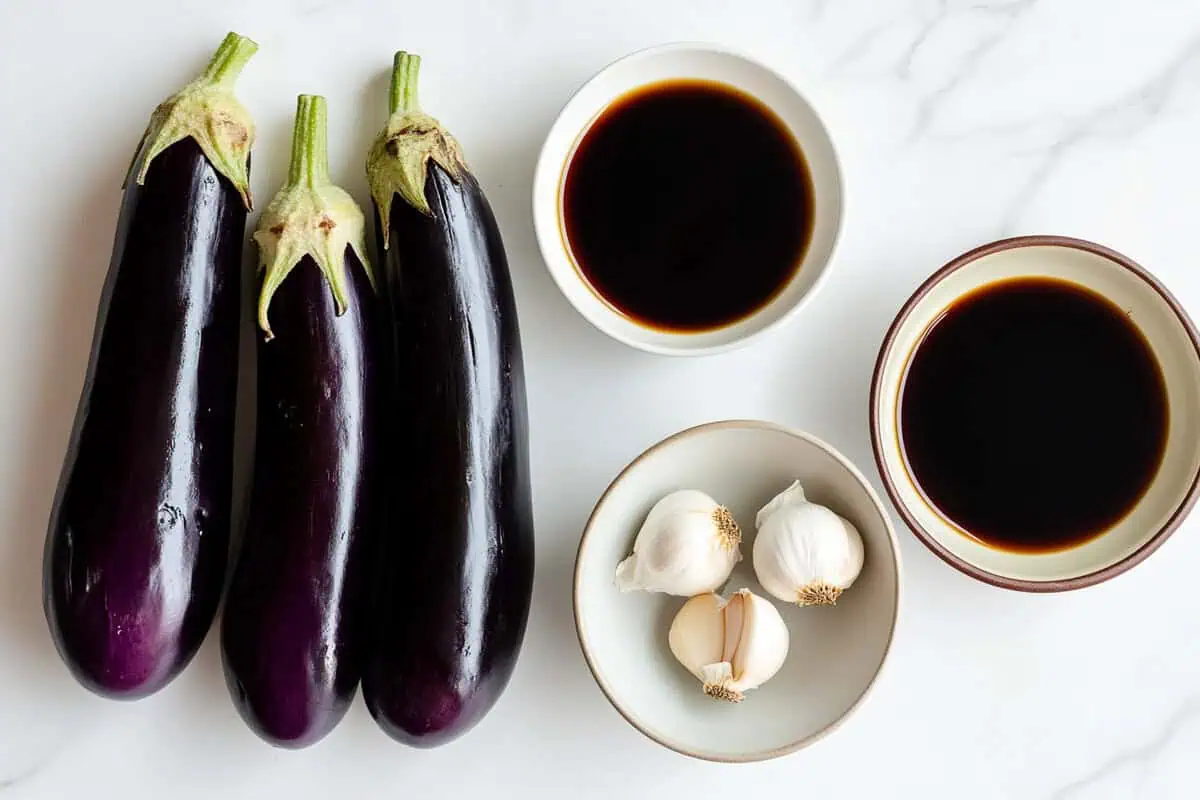
- 4 medium Filipino eggplants (stems trimmed and cut into 2-inch chunks)
- 4 tablespoons canola oil
- 5 cloves garlic (peeled and minced)
- ½ cup vinegar
- ½ cup water
- ¼ cup soy sauce
- 2 Thai chili peppers
- Salt and pepper to taste
Equipment
- Large skillet or frying pan
- Cutting board and knife
- Measuring cups and spoons
- Tongs for flipping the eggplant
- Paper towels for draining
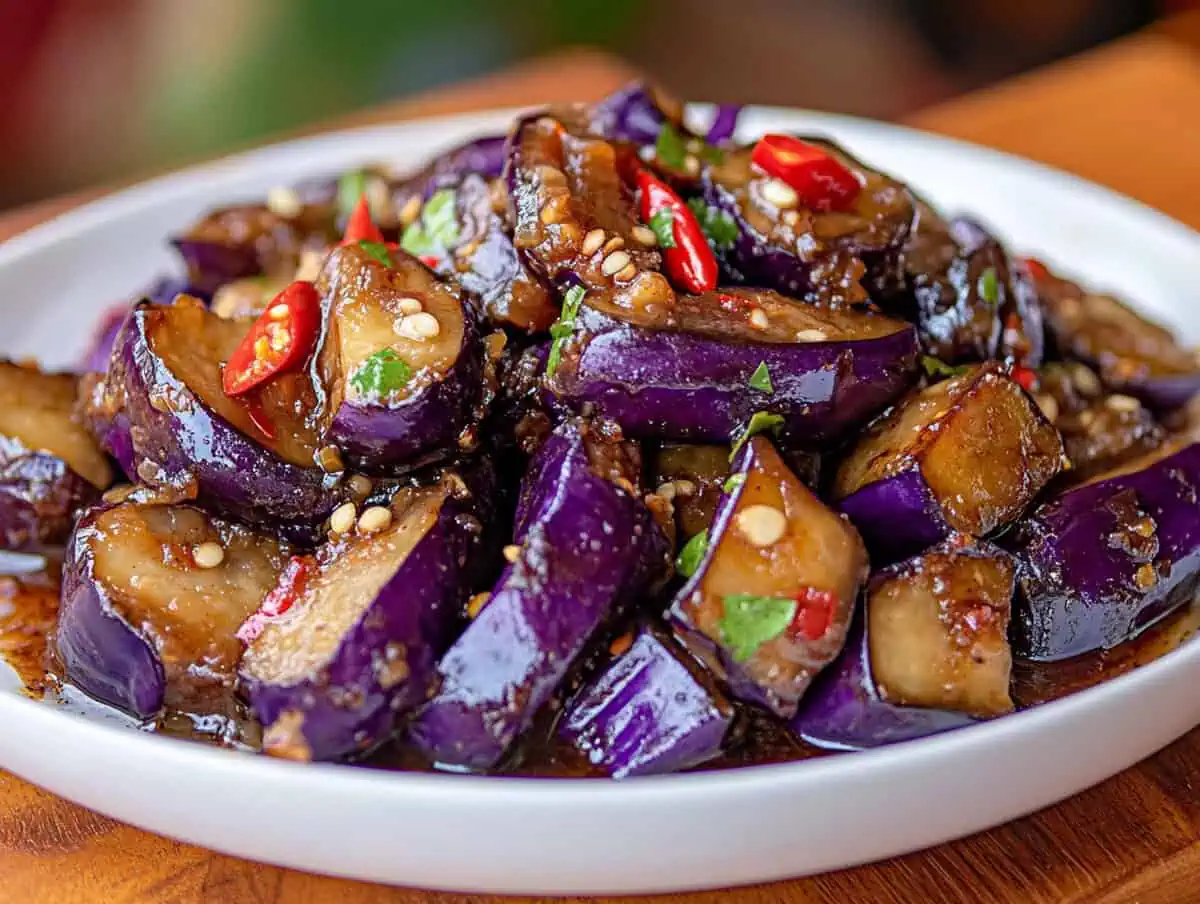
How To Make
- In a wide pan over medium heat, heat about 3 tablespoons of the oil. Add eggplant and cook until lightly browned. Remove from pan and drain on paper towels.
- In the same pan, heat the remaining 1 tablespoon oil. Add garlic and cook, stirring regularly, until lightly browned.
- Add vinegar, water, and soy sauce and bring to a boil, uncovered and without stirring, for about 2 to 3 minutes until slightly reduced.
- Add the browned eggplant and chili peppers. Cook, covered, for about 4 to 5 minutes or until tender.
- Season with salt and pepper to taste. Serve hot with steamed rice.

Tips from Lola's Kitchen
- Eggplant Selection: Choose firm eggplants with smooth, shiny skin and no soft spots for the best texture and flavor.
- Prevent Browning: After cutting your eggplants, immediately submerge them in salted water to prevent browning. This keeps them looking fresh until you're ready to cook.
- Flavor Development: For deeper flavor, let the vinegar and soy sauce reduce slightly before adding the eggplants. This concentrates the adobo flavors.
- Rest Time: Allow the dish to rest for 5-10 minutes after cooking. This gives the eggplants more time to absorb the flavorful sauce.
- Oil Absorption: Eggplants tend to absorb a lot of oil. Make sure to properly drain them on paper towels after the initial frying to remove excess oil.
Substitutions
- Eggplant Varieties: If Filipino eggplants aren't available, you can use Chinese eggplants or even regular globe eggplants cut into smaller pieces.
- Oil Options: While canola oil works great, you can substitute with vegetable oil, coconut oil, or even olive oil for a different flavor profile.
- Vinegar Variations: White vinegar is traditional, but you can experiment with apple cider vinegar or rice vinegar for a milder tanginess.
- Heat Level: If you prefer a milder dish, reduce or omit the Thai chili peppers. For extra heat, add more peppers or include some red pepper flakes.
- Soy Sauce Alternatives: For a gluten-free version, use tamari. For less sodium, try low-sodium soy sauce or coconut aminos.
Troubleshooting
- Mushy Eggplant: If your eggplant becomes too soft, you likely cooked it too long. Keep the cooking time brief during the initial frying and be careful not to overcook during the simmering stage.
- Bitter Taste: If your eggplant tastes bitter, try soaking it in salted water for 15-30 minutes before cooking to draw out the bitterness.
- Too Sour: If the adobo sauce is too tangy, add a teaspoon of sugar or a bit more water to balance the flavors.
- Too Salty: If the dish is too salty, add a bit more water and a splash of vinegar to dilute and balance the saltiness.
- Sauce Too Thin: If your sauce is too watery, simmer uncovered for a few extra minutes to reduce and thicken it.
Storage & Reheating
- Refrigeration: Store leftovers in an airtight container in the refrigerator for up to 3-4 days. The flavors actually improve over time as the eggplant continues to absorb the sauce.
- Freezing: While possible, freezing isn't recommended as the texture of the eggplant may become too soft when thawed.
- Reheating: Gently reheat on the stovetop over medium-low heat until warmed through. Add a splash of water if the sauce has thickened too much. You can also microwave in 30-second intervals, stirring between each interval.
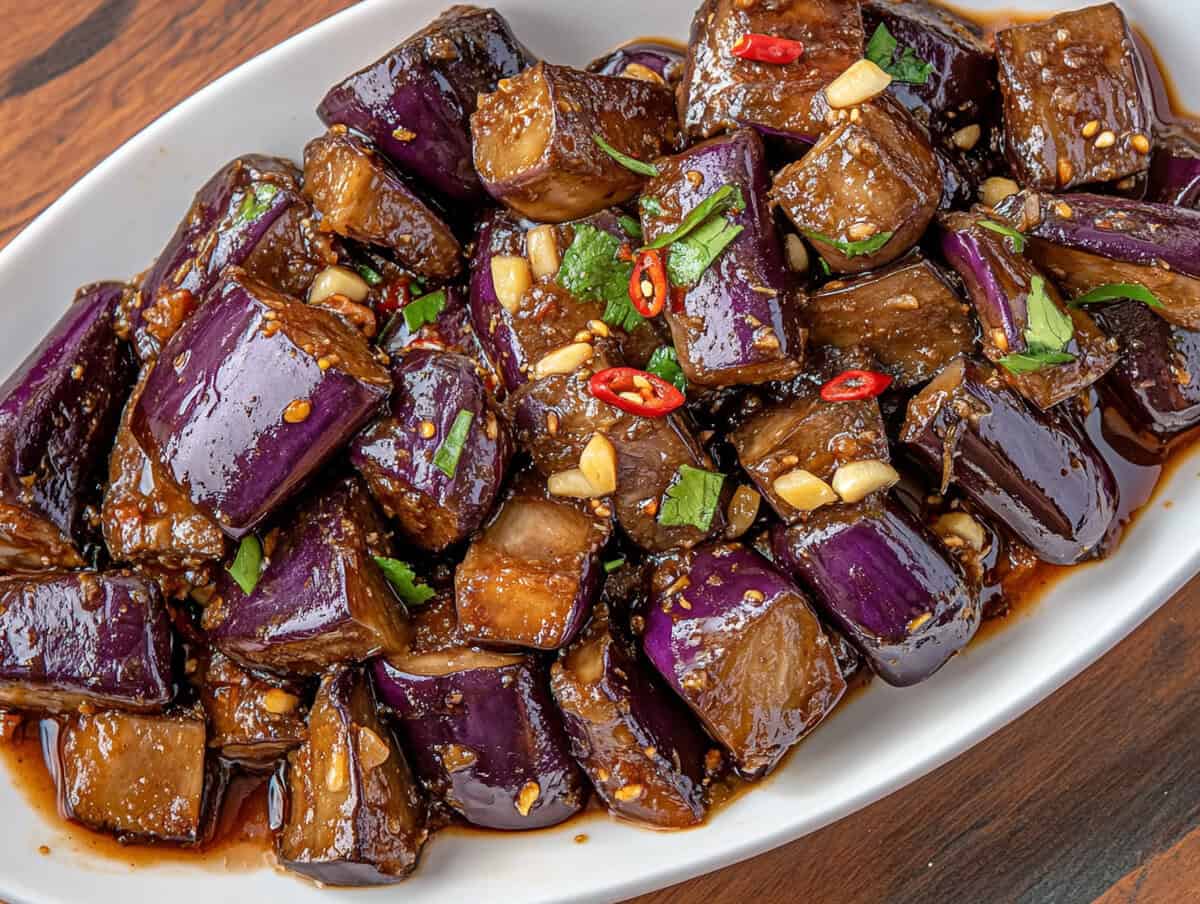
FAQ
Can I make this dish ahead of time?
Yes! In fact, Adobong Talong often tastes better the next day after the flavors have had time to meld together. Make it a day in advance and reheat when ready to serve.
Is this dish vegetarian?
Yes, this eggplant adobo is vegetarian. To make it vegan, ensure you're using a vegan-friendly soy sauce (some contain fish extracts).
Can I add meat to this recipe?
Absolutely! Pork, chicken, or even shrimp can be excellent additions. Cook the meat first until nearly done, then proceed with the recipe as written.
How spicy is this dish?
With 2 Thai chili peppers, it has a moderate heat level. Adjust the number of peppers based on your preference for spiciness.
What can I serve with Adobong Talong?
This dish pairs wonderfully with steamed rice, fried fish, grilled meats, or even as part of a larger Filipino feast with dishes like pancit (noodles) or lumpia (spring rolls).
Can I roast the eggplant instead of frying it?
Yes! For a healthier version, arrange eggplant slices in a single layer on a baking sheet, brush with olive oil, and bake at 425°F for about 10 minutes or until tender. Then proceed with the adobo sauce preparation.
Related
Looking for other recipes like this? Try these:
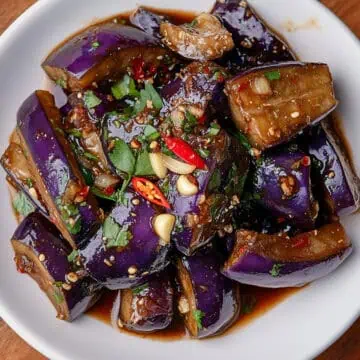
Adobong Talong (Filipino Eggplant Adobo)
Ingredients
- 4 medium Filipino eggplants stems trimmed and cut into 2-inch chunks
- 4 tablespoons canola oil
- 5 cloves garlic peeled and minced
- ½ cup vinegar
- ½ cup water
- ¼ cup soy sauce
- 2 Thai chili peppers
- Salt and pepper to taste
Instructions
- In a wide pan over medium heat, heat about 3 tablespoons of the oil. Add eggplant and cook until lightly browned. Remove from pan and drain on paper towels.
- In the same pan, heat the remaining 1 tablespoon oil. Add garlic and cook, stirring regularly, until lightly browned.
- Add vinegar, water, and soy sauce and bring to a boil, uncovered and without stirring, for about 2 to 3 minutes until slightly reduced.
- Add the browned eggplant and chili peppers. Cook, covered, for about 4 to 5 minutes or until tender.
- Season with salt and pepper to taste. Serve hot with steamed rice.
Tips from Lola's Kitchen
- Eggplant Selection: Choose firm eggplants with smooth, shiny skin and no soft spots for the best texture and flavor.
- Prevent Browning: After cutting your eggplants, immediately submerge them in salted water to prevent browning. This keeps them looking fresh until you're ready to cook.
- Flavor Development: For deeper flavor, let the vinegar and soy sauce reduce slightly before adding the eggplants. This concentrates the adobo flavors.
- Rest Time: Allow the dish to rest for 5-10 minutes after cooking. This gives the eggplants more time to absorb the flavorful sauce.
- Oil Absorption: Eggplants tend to absorb a lot of oil. Make sure to properly drain them on paper towels after the initial frying to remove excess oil.
The Story Behind Adobong Talong
Adobong Talong is a beautiful example of Filipino cuisine's resourcefulness and flavor-packed approach to cooking. Adobo, which comes from the Spanish word "adobar" meaning to marinate, has become the unofficial national dish of the Philippines. While most people think of chicken or pork adobo, vegetables like eggplant make for an equally delicious version that highlights the versatility of this cooking technique.
The history of adobo stretches back to pre-colonial times when ancient Filipinos discovered that cooking with vinegar helped preserve food in the tropical climate. When Spanish colonizers arrived in the 16th century, they observed this cooking method and named it "adobo," though it was already a well-established part of Filipino cuisine.
Eggplant (talong) has been cultivated in the Philippines for centuries and is a staple vegetable in many Filipino households. The slim, purple Filipino eggplant is particularly beloved for its tender flesh and mild flavor. When these eggplants are cooked adobo-style, they soak up the tangy-savory sauce beautifully, creating a dish that's both economical and incredibly satisfying.
In Filipino homes, Adobong Talong often appears as a side dish during casual family meals but can also take center stage as a vegetarian main dish, especially during hot summer months when lighter meals are preferred. It's also a popular choice during the Catholic observance of Lent when many Filipinos abstain from meat.
What makes this dish so special is how it transforms simple, everyday ingredients into something extraordinary. The combination of garlic, vinegar, and soy sauce creates that distinctive adobo flavor that Filipinos around the world recognize as the taste of home. Whether you're new to Filipino cuisine or looking to expand your recipe collection, this Adobong Talong recipe is a wonderful place to start your culinary journey.
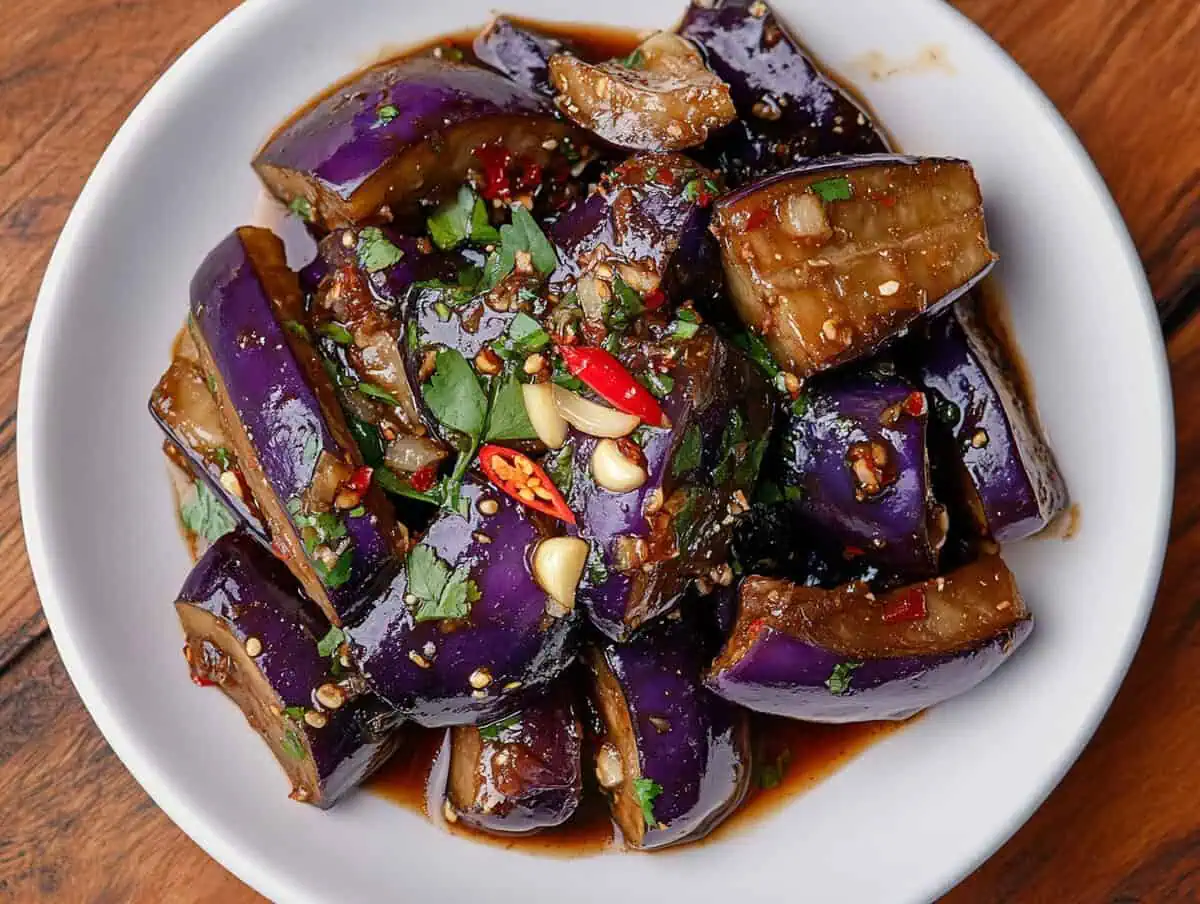









Comments
No Comments